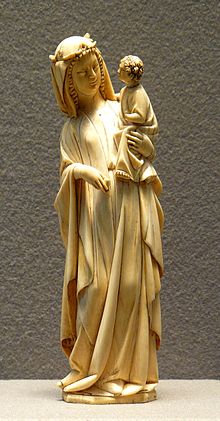
| French art history |
|---|
| Historical periods |
| French artists |
| Thematic |
| Movements |
| See also |
French art consists of the visual and plastic arts (including French architecture, woodwork, textiles, and ceramics) originating from the geographical area of France. Modern France was the main centre for the European art of the Upper Paleolithic,[citation needed] then left many megalithic monuments, and in the Iron Age many of the most impressive finds of early Celtic art. The Gallo-Roman period left a distinctive provincial style of sculpture, and the region around the modern Franco-German border led the empire in the mass production of finely decorated Ancient Roman pottery, which was exported to Italy and elsewhere on a large scale. With Merovingian art the story of French styles as a distinct and influential element in the wider development of the art of Christian Europe begins.
Romanesque and Gothic architecture flourished in medieval France with Gothic architecture originating from the Île-de-France and Picardy regions of northern France.[1][2] During the Renaissance led to Italy becoming the main source of stylistic developments until France matched Italy's influence during the Rococo and Neoclassicism periods[citation needed] During the 19th century and up to mid-20 century France and especially Paris was considered the center of the art world with art styles such as Impressionism, Post-Impressionism, Cubism, Fauvism originating there as well as movements and congregations of foreign artists such as the École de Paris.[3][4][5][6][7][8]
- ^ carolinarh (2015-10-10). "French Romanesque I: Architecture". The Artistic Adventure of Mankind. Retrieved 2023-12-30.
- ^ Rudolph, Conrad, ed. (1 January 2006). A Companion to Medieval Art: Romanesque and Gothic in Northern Europe. doi:10.1002/9780470996997. ISBN 978-0-470-99699-7.
- ^ Tate. "Impressionism". Tate. Retrieved 2023-12-30.
- ^ "School of Paris". www.nationalgalleries.org. Retrieved 2023-12-30.
- ^ Rewald, Authors: Sabine. "Fauvism | Essay | The Metropolitan Museum of Art | Heilbrunn Timeline of Art History". The Met’s Heilbrunn Timeline of Art History. Retrieved 2023-12-30.
- ^ Rewald, Authors: Sabine. "Cubism | Essay | The Metropolitan Museum of Art | Heilbrunn Timeline of Art History". The Met’s Heilbrunn Timeline of Art History. Retrieved 2023-12-30.
- ^ Benjamin, Walter (1969). "Paris: Capital of the Nineteenth Century". Perspecta. 12: 165–172. doi:10.2307/1566965. ISSN 0079-0958. JSTOR 1566965.
- ^ HIGONNET, Patrice L. R. (2009-06-30). Paris: Capital of the World. Harvard University Press. ISBN 978-0-674-03864-6.